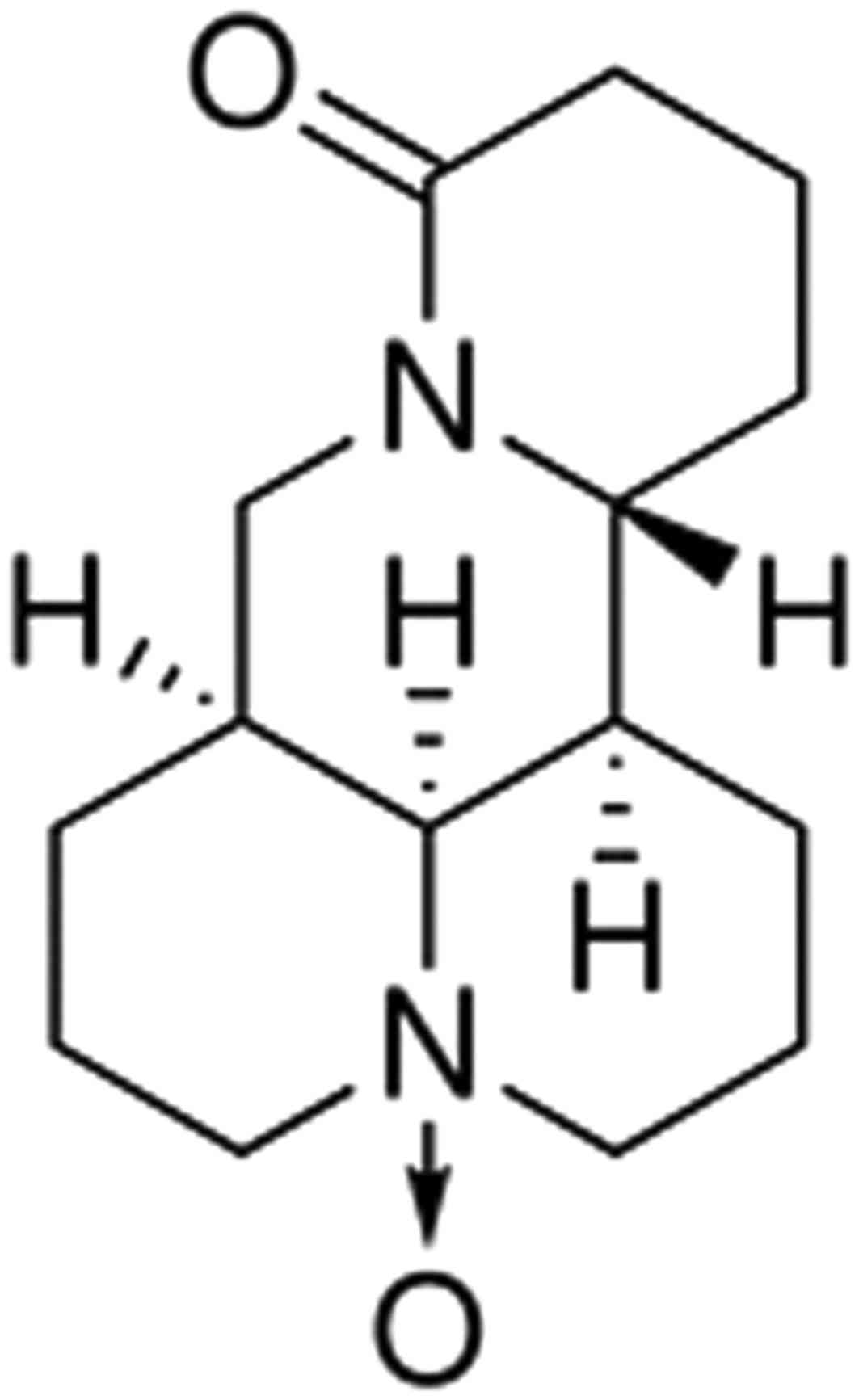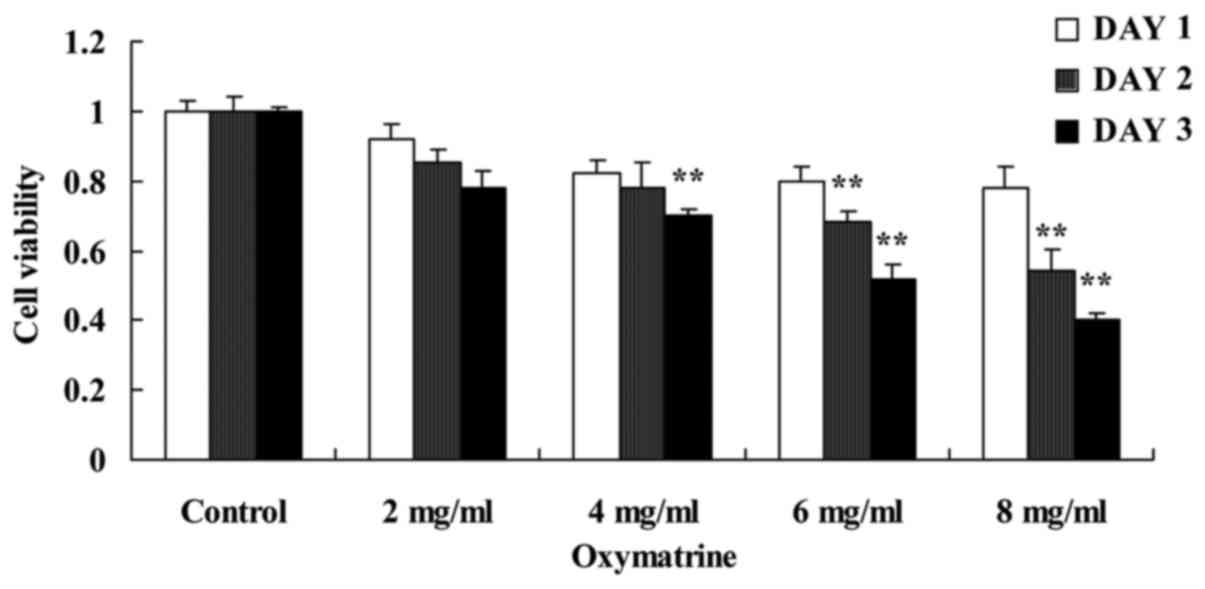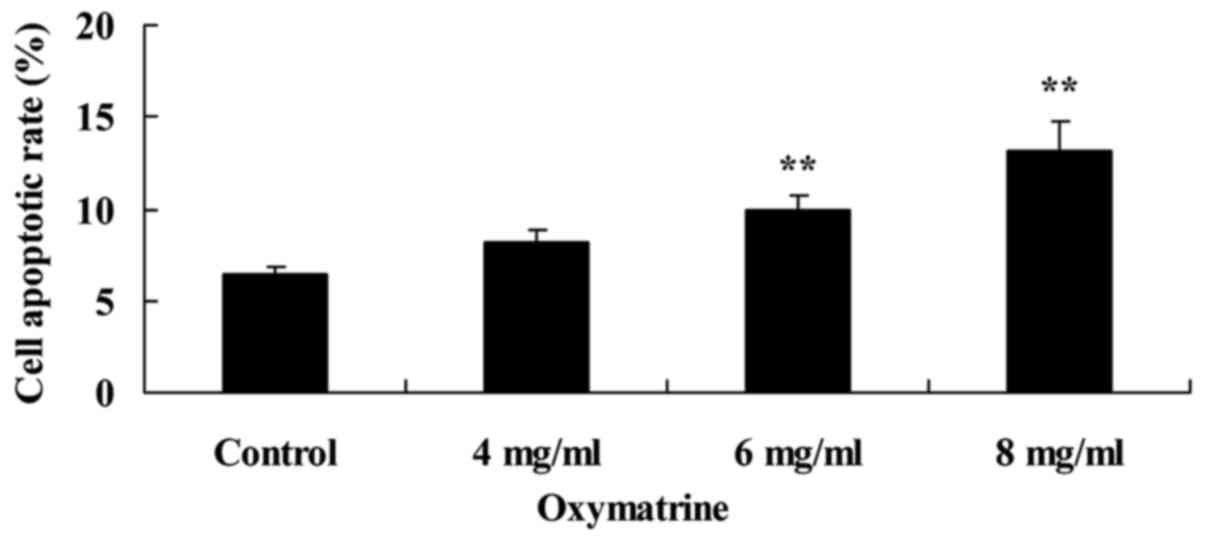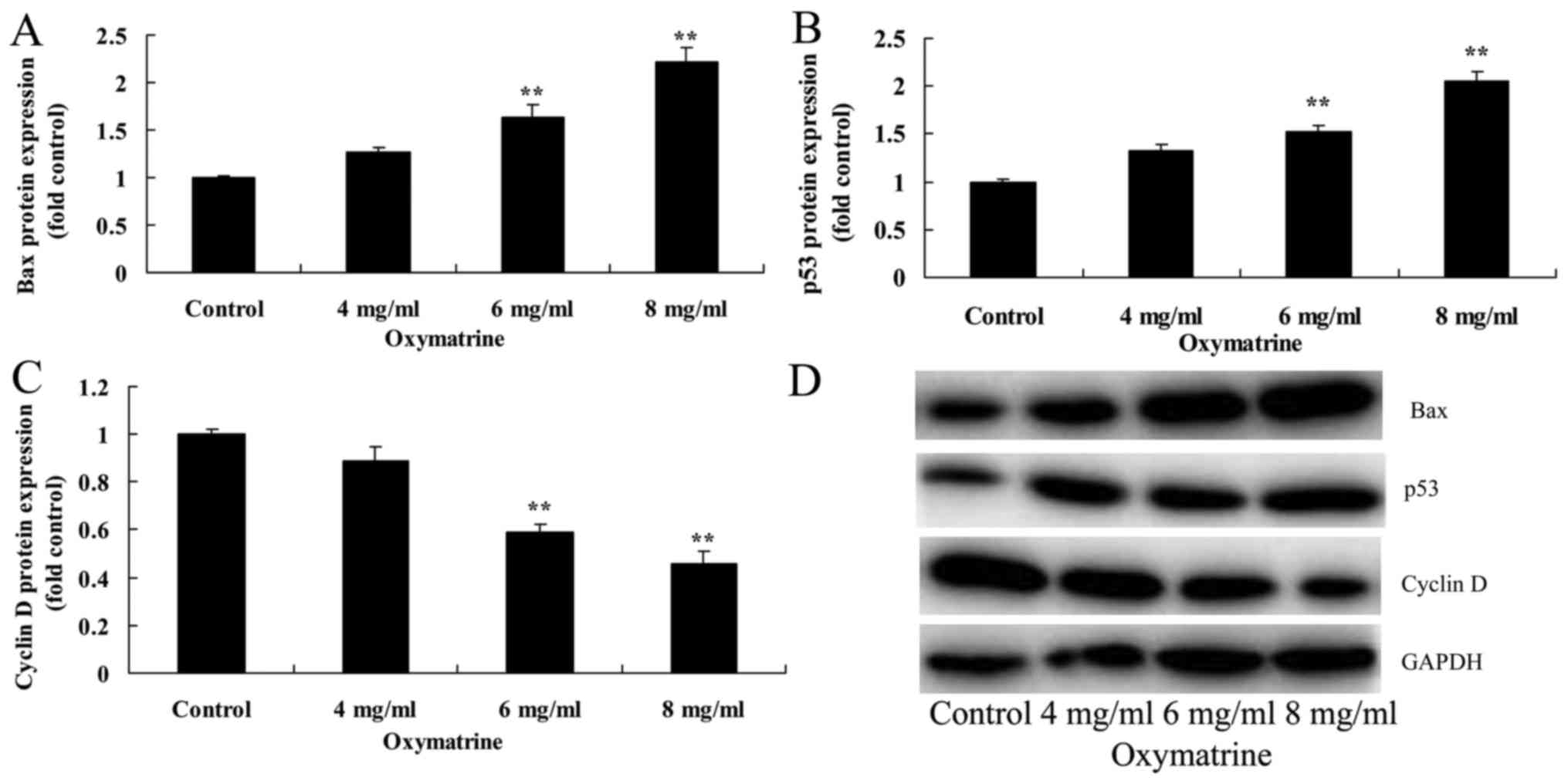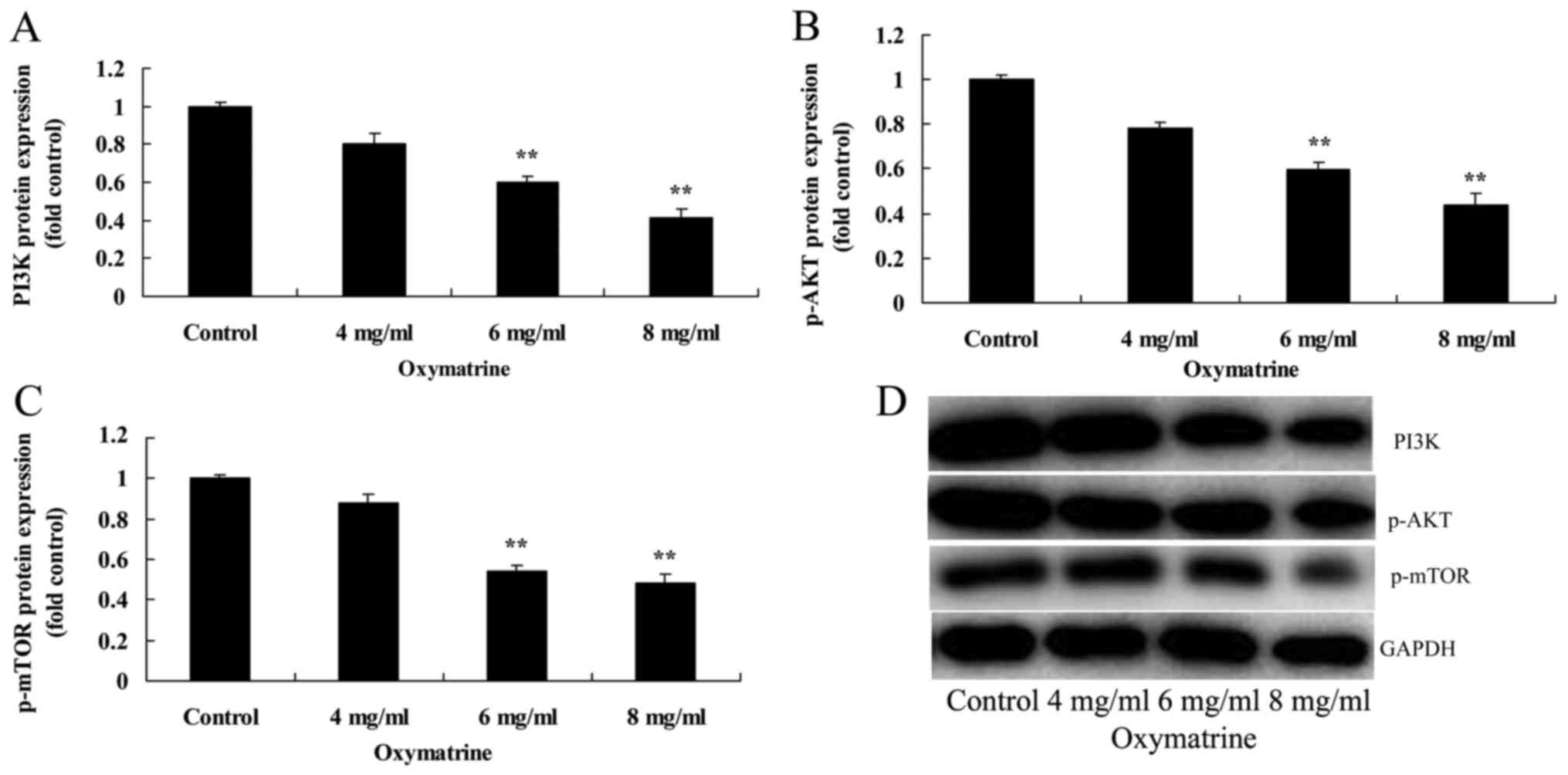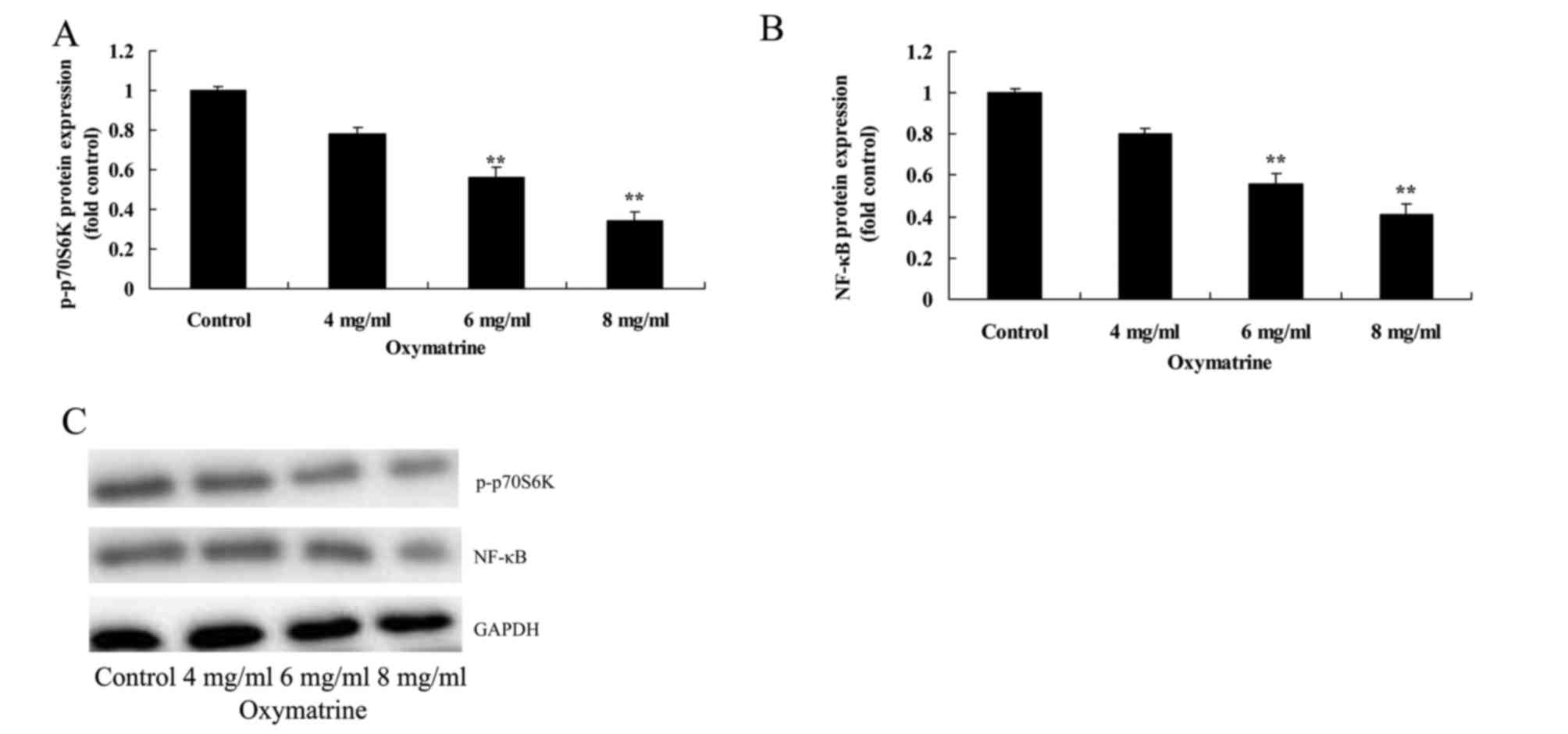Oxymatrine induces nasopharyngeal cancer cell death through inhibition of PI3K/AKT and NF‑κB pathways
- Authors:
- Published online on: October 19, 2017 https://doi.org/10.3892/mmr.2017.7822
- Pages: 9701-9706
Abstract
Introduction
Nasopharyngeal carcinoma (NPC) is a malignant tumor that occurs in epithelial cells of the nasopharynx and is closely related to Epstein-Barr virus infection, with an annual incidence rate of 10–50 out of 100,000 worldwide (1). It is rare in most regions of the world, and its annual incidence rate is only 0.5–0.6 out of 100,000 in Europe and the United States. The 5-year overall survival of NPC is 84% of non-metastatic cases with intensity-modulated radiation therapy (IMRT) and optimal chemotherapy (2,3).
Recently, the phosphoinositide 3 kinase (PI3K)/AKT signaling transduction pathway has attracted increasing attention (4). Previous studies have reported that the PI3K/AKT signaling pathway is important in the signal transduction of various growth factors, and is closely related to cellular physiological functions as well as the incidence and development of certain tumors (5,6). The products of PI3K3-phosphoinositide, that is 3,4-diphosphoinositide and 3,4,5-inositol triphosphate, bind to the PH domain of AKT and induce a conformational change and the subsequent phosphorylation and activation of AKT, which migrates from the cytoplasm to the cell membrane, where it directly or indirectly activates its downstream molecule proteins, such as mammalian target of rapamycin (mTOR), p70 ribosomal protein S6 kinase (p70S6K), matrix metalloproteinase (MMP)-2, and nuclear factor-κB (NF-κB) and insulin-like growth factor I receptor (IGF-IR) (7). The activation of mTOR and p70S6K initiates protein translation to promote protein synthesis; the activation of NF-κB promotes the transcription of apoptosis-inhibiting genes and upregulates the mRNA and protein expression of IGF-IR and MMP2, thus promoting the invasion and metastasis of cancer cells (8). Therefore, the PI3K/AKT signaling pathway may be considered to serve an important role in cell proliferation, differentiation and migration.
The NF-κB family of transcription factors promotes tumorigenesis, and functional proteins encoded by NF-κB may promote tumor growth; NF-κB may promote tumorigenesis by inhibiting apoptosis (9). NF-κB is inactive in patients with head and neck squamous carcinoma, and inhibiting RelA can increase apoptosis in tumor cells (10). NF-κB may be an important indicator in the early diagnosis and treatment of tumors (10).
Oxymatrine is a compound (Fig. 1) extracted from radix sophorae flavescentis that has been previously reported to exhibit antitumoral effects, mainly by inhibiting the differentiation and apoptosis of tumor cells, suppressing the proliferation and metastasis of tumor cells, inhibiting the activity of telomerase, suppressing tumor angiogenesis, inhibiting drug resistance of tumor and promoting antitumor immune response of the host (11,12). The present study investigated the anticancer effects of oxymatrine on NPC cell death and the underlying molecular mechanisms of these effects.
Materials and methods
Cell culture
The human NPC HK-1 cell line was obtained from the Experimental Center of Capital Medical University (Beijing, China) and cells were maintained in RPMI-1640 medium (Invitrogen; Thermo Fisher Scientific, Inc., Waltham, MA, USA) containing 10% fetal bovine serum (Invitrogen; Thermo Fisher Scientific, Inc.), 100 U/ml penicillin and 100 mg/ml streptomycin in a humidified atmosphere containing 5% CO2 at 37°C.
Cell proliferation assay
HK-1 cells were seeded (1,000 cells/well) into 96-well plates, incubated overnight and treated with oxymatrine (0, 2, 4, 6 and 8 mg/ml; Sigma-Aldrich; Merck KGaA, Darmstadt, Germany) for 1, 2 and 3 days at 37°C. MTT (10 ml; 5 mg/ml; Beyotime Institute of Biotechnology, Haimen, China) was added and was incubated in darkness for 4 h at 37°C. The media was removed and dimethylsulfoxide was added to dissolve the formazan crystals for 20 min; the absorbance was measured using a FluoDia T70 microplate reader (Photon Technology International, Inc.; Horiba, Ltd., Stanmore, UK) at a wavelength of 490 nm.
Flow cytometric analysis
HK-1 cells were seeded (1–2×105 cells/well) into 6-well plates, incubated overnight and treated with oxymatrine (0, 4, 6 and 8 mg/ml) for 2 days. Cells were centrifuged at 1,000 × g at 4°C for 10 min and washed using PBS three times. Cells were stained using an Annexin V-fluorescein isothiocyanate (FITC)/propidium iodide (PI) Cell Apoptosis Detection kit (BD Biosciences, Franklin Lakes, NJ, USA) according to the manufacturer's protocols, and fluorescence was determined using a FACSCalibur flow cytometer (BD Biosciences) and analyzed using Flowjo version 7.6.1 (FlowJo LLC, Ashland, OR, USA).
Caspase-3 and caspase-9 activities
HK-1 cells were seeded (1–2×105 cells/well) into 6-well plates, incubated overnight and treated with oxymatrine (0, 4, 6 and 8 mg/ml) for 2 days at 37°C. Cell protein extracts were prepared in radioimmunoprecipitation assay (RIPA) buffer (Beyotime Institute of Biotechnology) for 15 min. The protein concentrations were determined using the BCA Protein Assay kit (Beyotime Institute of Biotechnology). Equal amounts of proteins (50 µg per condition) were incubated with Caspase-3/9 activities kits (C1115 or C1157; Beyotime Institute of Biotechnology) for 1–2 h at 37°C. Absorbance was measured using a FluoDia T70 microplate reader (Photon Technology International, Inc.; Horiba, Ltd.) at a wavelength of 405 nm and analyzed using SPSS version 17.0 (SPSS, Inc., Chicago, IL, USA).
Western blot analysis
HK-1 cells were seeded (1–2×105 cells/well) into 6-well plates, incubated overnight and treated with oxymatrine (0, 4, 6 and 8 mg/ml) for 2 days. Protein extracts were prepared in RIPA for 15 min. Protein concentrations were determined using the BCA Protein Assay kit (Beyotime Institute of Biotechnology). Equal amounts of proteins (50 µg) were separated by 8–10% SDS-PAGE and transferred to polyvinyl difluoride membranes (EMD Millipore, Billerica, MA, USA). Membranes were blocked in PBS with 5% skimmed milk powder for 1 h at 37°C and 0.1% Tween-20 and incubated with primary antibodies against p53 (sc-6243; 1:500; Santa Cruz Biotechnology, Inc., Dallas, TX, USA), Bax (sc-493; 1:500), cyclin D (sc-25764; 1:500), PI3K (sc-7174; 1:500), phosphorylated (p)-AKT (sc-135650; 1:500), p-mTOR p-p70S6K (sc-8416; 1:500), NF-κB (sc-109; 1:500) and GAPDH (sc-25778; 1:500; all from Santa Cruz Biotechnology, Inc., Dallas, TX, USA) overnight at 4°C. Following washes with Tris-buffered saline and 0.1% Tween-20, membranes were incubated with horseradish peroxidase-conjugated anti-mouse or anti-rabbit secondary antibody (sc-2005 or sc-2004; 1:5,000; Santa Cruz Biotechnology, Inc.) for 1 h at 37°C and visualized using the Enhanced Chemiluminescence Detection reagent (BD Biosciences) and analyzed using ImageLab version 3.0 (BD Biosciences).
Statistical analysis
Data are expressed as the mean ± standard deviation (n=3), and statistical analysis was carried out using SPSS version 17.0 (SPSS, Inc.). Statistically significant differences between groups were determined by one-way analysis of variance and Tukey's post hoc test. P<0.05 was considered to indicate a statistically significant difference.
Results
Oxymatrine inhibits NPC cell proliferation
To investigate the putative anticancer effects of oxymatrine on NPC cell growth, HK-1 cells were treated with various concentrations of oxymatrine. Results from the MTT assays suggested that oxymatrine inhibited cell proliferation of HK-1 cell in a time- and dose-dependent manner (Fig. 2). Treatment with 4, 6 and 8 mg/ml of oxymatrine significantly inhibited cell proliferation of HK-1 cells, compared with the untreated Control group (Fig. 2).
Oxymatrine induces NPC cell apoptosis
Oxymatrine-induced NPC cell apoptosis was measured using Annexin V-FITC/PI double staining. The results demonstrated that 6 and 8 mg/ml of oxymatrine treatment significantly induced NPC HK-1 cell apoptosis, compared with cells in the untreated Control group (Fig. 3).
Oxymatrine induces the activity of caspase-3 and caspase-9 in NPC cells
The effects of oxymatrine treatment on inducing the activities of caspase-3 and caspase-9 in NPC HK-1 cells were determined. Oxymatrine exposure increased the activities of both caspase-3 and caspase-9, compared with the Control group (Fig. 4).
Oxymatrine affects the protein expression levels of Bax, p53 and cyclin D in NPC cells
The effects of oxymatrine on Bax, p53 and cyclin D protein expression of NPC HK-1 cells were examined. Compared with cells in the untreated Control group, oxymatrine treatment at 6 and 8 mg/ml significantly induced the protein expression of Bax and p53, and suppressed cyclin D protein expression (Fig. 5).
Oxymatrine suppressed the protein expression levels of PI3K, p-AKT and p-mTOR in NPC cells
To investigate the possible molecular mechanisms underlying oxymatrine-induced NPC cell apoptosis, PI3K/AKT signaling was analyzed following treatment with different concentrations of oxymatrine. Western blotting results suggested that oxymatrine treatment at 6 and 8 mg/ml significantly suppressed the protein expressions of PI3K, p-AKT and p-mTOR of HK-1 cell, compared with the Control group (Fig. 6).
Oxymatrine suppresses the protein expression levels of p-p70S6K and NF-κB in NPC cells
To further understand the role of p70S6K in oxymatrine-induced nasopharynx cancer cell apoptosis, p-p70S6K and NF-κB protein expression levels were analyzed in NPC HK-1 cells treated with various concentrations of oxymatrine. Compared with cells in the untreated Control group, oxymatrine treatment at 6 and 8 mg/ml significantly suppressed the protein expression levels of p-p70S6K and NF-κB (Fig. 7).
Discussion
NPC is a common malignant tumor in southern China, and is characterized by high racial susceptibility, regional aggregation and family tendency (13). The cause of NPC remains unknown, but it is currently considered to be related to genetic factors, environmental factors and viral infection (14). The clinical symptoms of NPC are complicated and diverse, are easy to be misdiagnosed or may by ignored by patients, and include clinical characteristics such as high degree of malignancy, early cervical lymph node metastasis and distant metastasis (15). Data from the present study demonstrated that oxymatrine treatment significantly inhibited cell proliferation and induced NPC cell apoptosis in HK-1 cells.
Bcl2 is an apoptosis-regulator that has been thoroughly studied, and its change in expression not only affects normal apoptosis of damaged DNA cells and abnormal cells, but also the apoptosis of tumor cells (16). Bcl2 proteins are highly expressed in NPC tissues and atypical hyperplasia epithelium, which suggested that Bcl2 proteins may serve an important role in the early stage of NPC, and the overexpression of Bcl2 may also be related to the inhibition of the apoptosis of NPC (17). The present study demonstrated that oxymatrine increased the expression levels of caspase-3 and caspase-9 and Bax protein expression of HK-1 cell.
p53 has been reported to have at close relationship with human tumors, and functions to block cell cycle, inhibit cell proliferation, induce cell differentiation, initiate apoptosis and maintain the stability of genome (16). In the present study, higher concentrations of oxymatrine treatment (6 and 8 mg/ml) significantly induced the protein expression of p53 in NPC HK-1 cells. A previous study suggested that oxymatrine inhibits prostate cancer cell proliferation through p53 and Bax/Bcl2 expression (18).
Cyclin D1 (also known as Bcl-1) is encoded by CCND1, which is located on chromosome 11q13, comprises 5 exons and 4 introns, and is 15 kb long (19). Cyclin D1 is a nuclear protein that serves an important role in the regulation of the G1 stage of the cell cycle. Overexpression of cyclin D1 may lead to the disorder of regulation and detection point at G1/S stage, thus accelerating cell cycle progression and inducing irreversible abnormal proliferation, which results in disordered cell proliferation and regulation (20). As a regulatory factor of cell cycle, cyclin D1 has a close relationship with cell proliferation, it participates in the regulation of cell cycle, and reflects proliferative activity of cells to a certain extent, and the proliferative activity of tumor cells is one of crucial factors affecting the radiosensitivity of NPC (21). Overall, the results of the present study suggested that oxymatrine significantly suppressed the protein expression of cyclin D of HK-1 cell. Another study reported that oxymatrine enhances the antitumor activity of oxaliplatin on colon cancer cell growth by downregulating cyclin D expression and the PI3K/AKT/mTOR pathway (22).
Previous studies have indicated that the biological function of the PI3K/AKT signaling pathway is closely related to the survival of tumor cells, glucose metabolism and the incidence and development of tumors (5,23). There are extensive and in-depth studies on the effects of PI3K/AKT signaling in the occurrence and development, as well as resistance to radiotherapy, chemotherapy and drugs, of malignant tumors (5,23). One previous study reported that AKT was highly expressed and the activity of AKT kinase was increased in ovarian cancer tissues, which was associated with the biological behaviors of malignant tumors (24). Other studies have demonstrated that the incidence and development of prostate cancer, cervical cancer, non-small cell lung cancer and other malignant tumors are closely related to the activation of the PI3K/AKT signaling pathway (5,25). In the present study, oxymatrine treatment significantly reduced the protein expression levels of PI3K, p-AKT, p-mTOR and p-p70S6K in NPC HK-1 cells.
NF-κB belongs to a family of tumorigenesis proteins, and several functional proteins encoded by NF-κB may promote tumor growth (10). The cyclin D1 promoter region contains two NF-κB binding sites, and the activation of NF-κB promotes conversion function of the expression of cyclin D1 and G1/S, which accelerates cell cycle progression (26). NF-κB may also promote tumorigenesis by inhibiting apoptosis (27). In vitro experiments demonstrated that specifically inhibiting the activity of NF-κB was able to block the cell cycle in glioma cell lines and induce the apoptosis of tumor cells, whereas in vivo experiments confirmed that NF-κB inhibited the growth of glioma cells in rats (27). The results of the present study revealed that oxymatrine treatment suppressed the protein expression of NF-κB in NPC HK-1 cells. A previous study demonstrated that oxymatrine inhibited epithelial-mesenchymal transition of colorectal cancer cells through the regulation of NF-κB signaling (11).
In conclusion, the results of the present study demonstrated that oxymatrine significantly inhibited cell proliferation, induced NPC cell apoptosis, increased caspase-3 and caspase-9 activities, promoted p53 and Bax protein expression and suppressed cyclin D protein expression in NPC HK-1 cells through the regulation of PI3K/AKT and NF-κB pathway. Therefore, these findings may provide a novel approach for the development of oxymatrine, which is derived from TCM herb, as a potential NPC therapy.
References
|
Casanova M, Özyar E, Patte C, Orbach D, Ferrari A, Veyrat-Follet C, Errihani H, Pan J, Zhang L, Shen L, et al: International randomized phase 2 study on the addition of docetaxel to the combination of cisplatin and 5-fluorouracil in the induction treatment for nasopharyngeal carcinoma in children and adolescents. Cancer Chemother Pharmacol. 77:289–298. 2016. View Article : Google Scholar : PubMed/NCBI | |
|
Chen Y, Liu MZ, Liang SB, Zong JF, Mao YP, Tang LL, Guo Y, Lin AH, Zeng XF and Ma J: Preliminary results of a prospective randomized trial comparing concurrent chemoradiotherapy plus adjuvant chemotherapy with radiotherapy alone in patients with locoregionally advanced nasopharyngeal carcinoma in endemic regions of china. Int J Radiat Oncol Biol Phys. 71:1356–1364. 2008. View Article : Google Scholar : PubMed/NCBI | |
|
Li JG, Yuan X, Zhang LL, Tang YQ, Liu L, Chen XD, Gong XC, Wan GF, Liao YL, Ye JM and Ao F: A randomized clinical trial comparing prophylactic upper versus whole-neck irradiation in the treatment of patients with node-negative nasopharyngeal carcinoma. Cancer. 119:3170–3176. 2013. View Article : Google Scholar : PubMed/NCBI | |
|
Zhao M, Luo R, Liu Y, Gao L, Fu Z, Fu Q, Luo X, Chen Y, Deng X, Liang Z, et al: miR-3188 regulates nasopharyngeal carcinoma proliferation and chemosensitivity through a FOXO1-modulated positive feedback loop with mTOR-p-PI3K/AKT-c-JUN. Nat Commun. 7:113092016. View Article : Google Scholar : PubMed/NCBI | |
|
Zheng D, Zhu G, Liao S, Yi W, Luo G, He J, Pei Z, Li G and Zhou Y: Dysregulation of the PI3K/Akt signaling pathway affects cell cycle and apoptosis of side population cells in nasopharyngeal carcinoma. Oncol Lett. 10:182–188. 2015.PubMed/NCBI | |
|
Viana LR and Gomes-Marcondes MC: A leucine-rich diet modulates the tumor-induced down-regulation of the MAPK/ERK and PI3K/Akt/mTOR signaling pathways and maintains the expression of the ubiquitin-proteasome pathway in the placental tissue of NMRI mice. Biol Reprod. 92:492015. View Article : Google Scholar : PubMed/NCBI | |
|
Wong CH, Loong HH, Hui CW, Lau CP, Hui EP, Ma BB and Chan AT: Preclinical evaluation of the PI3K-mTOR dual inhibitor PF-04691502 as a novel therapeutic drug in nasopharyngeal carcinoma. Invest New Drugs. 31:1399–1408. 2013. View Article : Google Scholar : PubMed/NCBI | |
|
Tasioudi KE, Sakellariou S, Levidou G, Theodorou D, Michalopoulos NV, Patsouris E, Korkolopoulou P and Saetta AA: Immunohistochemical and molecular analysis of PI3K/AKT/mTOR pathway in esophageal carcinoma. APMIS. 123:639–647. 2015. View Article : Google Scholar : PubMed/NCBI | |
|
Shin SY, Kim CG, Jung YJ, Lim Y and Lee YH: The UPR inducer DPP23 inhibits the metastatic potential of MDA-MB-231 human breast cancer cells by targeting the Akt-IKK-NF-κB-MMP-9 axis. Sci Rep. 6:341342016. View Article : Google Scholar : PubMed/NCBI | |
|
Zheng H, Dai W, Cheung AK, Ko JM, Kan R, Wong BW, Leong MM, Deng M, Kwok TC, Chan JY, et al: Whole-exome sequencing identifies multiple loss-of-function mutations of NF-κB pathway regulators in nasopharyngeal carcinoma. Proc Natl Acad Sci USA. 113:pp. 11283–11288. 2016; View Article : Google Scholar : PubMed/NCBI | |
|
Liang L and Huang J: Oxymatrine inhibits epithelial-mesenchymal transition through regulation of NF-κB signaling in colorectal cancer cells. Oncol Rep. 36:1333–1338. 2016. View Article : Google Scholar : PubMed/NCBI | |
|
Lin B, Li D and Zhang L: Oxymatrine mediates Bax and Bcl-2 expression in human breast cancer MCF-7 cells. Pharmazie. 71:154–157. 2016.PubMed/NCBI | |
|
Peng PJ, Ou XQ, Chen ZB, Liao H, Peng YL, Wang SY, Zhang HY and Lin Z: Multicenter phase II study of capecitabine combined with nedaplatin for recurrent and metastatic nasopharyngeal carcinoma patients after failure of cisplatin-based chemotherapy. Cancer Chemother Pharmacol. 72:323–328. 2013. View Article : Google Scholar : PubMed/NCBI | |
|
Chen Y, Sun Y, Liang SB, Zong JF, Li WF, Chen M, Chen L, Mao YP, Tang LL, Guo Y, et al: Progress report of a randomized trial comparing long-term survival and late toxicity of concurrent chemoradiotherapy with adjuvant chemotherapy versus radiotherapy alone in patients with stage III to IVB nasopharyngeal carcinoma from endemic regions of China. Cancer. 119:2230–2238. 2013. View Article : Google Scholar : PubMed/NCBI | |
|
Zhang Y, Zhao L, Huang P, Wu J, Wang F, Huang Y and Zhang L: Open-label, single-arm phase II study of pemetrexed in the treatment of patients with recurrent or metastatic nasopharyngeal carcinoma who have had prior platinum-based chemotherapy. Cancer Chemother Pharmacol. 70:611–615. 2012. View Article : Google Scholar : PubMed/NCBI | |
|
Bourouba M, Benyelles-Boufennara A, Terki N, Baraka-Kerboua E, Bouzid K and Touil-Boukoffa C: Epidermal growth factor receptor (EGFR) abundance correlates with p53 and Bcl-2 accumulation and patient age in a small cohort of North African nasopharyngeal carcinoma patients. Eur Cytokine Netw. 22:38–44. 2011.PubMed/NCBI | |
|
Kao CL, Cho J, Lee YZ, Cheng YB, Chien CY, Hwang CF, Hong YR, Tseng CN and Cho CL: Ethanolic extracts of pluchea indica induce apoptosis and antiproliferation effects in human nasopharyngeal carcinoma cells. Molecules. 20:11508–11523. 2015. View Article : Google Scholar : PubMed/NCBI | |
|
Wu C, Huang W, Guo Y, Xia P, Sun X, Pan X and Hu W: Oxymatrine inhibits the proliferation of prostate cancer cells in vitro and in vivo. Mol Med Rep. 11:4129–4134. 2015. View Article : Google Scholar : PubMed/NCBI | |
|
Xu M, Cheung CC, Chow C, Lun SW, Cheung ST and Lo KW: Overexpression of PIN1 enhances cancer growth and aggressiveness with cyclin D1 induction in EBV-associated nasopharyngeal carcinoma. PLoS One. 11:e01568332016. View Article : Google Scholar : PubMed/NCBI | |
|
Liao D, Wu Y, Pu X, Chen H, Luo S, Li B, Ding C, Huang GL and He Z: Cyclin D1 G870A polymorphism and risk of nasopharyngeal carcinoma: A case-control study and meta-analysis. PLoS One. 9:e1132992014. View Article : Google Scholar : PubMed/NCBI | |
|
Peng G, Cao RB, Li YH, Zou ZW, Huang J and Ding Q: Alterations of cell cycle control proteins SHP-1/2, p16, CDK4 and cyclin D1 in radioresistant nasopharyngeal carcinoma cells. Mol Med Rep. 10:1709–1716. 2014. View Article : Google Scholar : PubMed/NCBI | |
|
Liu Y, Bi T, Wang Z, Wu G, Qian L, Gao Q and Shen G: Oxymatrine synergistically enhances antitumor activity of oxaliplatin in colon carcinoma through PI3K/AKT/mTOR pathway. Apoptosis. 21:1398–1407. 2016. View Article : Google Scholar : PubMed/NCBI | |
|
Yu X, Zhen Y, Yang H, Wang H, Zhou Y, Wang E, Marincola FM, Mai C, Chen Y, Wei H, et al: Loss of connective tissue growth factor as an unfavorable prognosis factor activates miR-18b by PI3K/AKT/C-Jun and C-Myc and promotes cell growth in nasopharyngeal carcinoma. Cell Death Dis. 4:e6342013. View Article : Google Scholar : PubMed/NCBI | |
|
Yuen JW, Chung GT, Lun SW, Cheung CC, To KF and Lo KW: Epigenetic inactivation of inositol polyphosphate 4-phosphatase B (INPP4B), a regulator of PI3K/AKT signaling pathway in EBV-associated nasopharyngeal carcinoma. PLoS One. 9:e1051632014. View Article : Google Scholar : PubMed/NCBI | |
|
Chen J: Roles of the PI3K/Akt pathway in Epstein-Barr virus-induced cancers and therapeutic implications. World J Virol. 1:154–161. 2012. View Article : Google Scholar : PubMed/NCBI | |
|
Zhu DD, Zhang J, Deng W, Yip YL, Lung HL, Tsang CM, Law WT, Yang J, Lau VM, Shuen WH, et al: Significance of NF-κB activation in immortalization of nasopharyngeal epithelial cells. Int J Cancer. 138:1175–1185. 2016. View Article : Google Scholar : PubMed/NCBI | |
|
Lin ML, Lu YC, Chung JG, Wang SG, Lin HT, Kang SE, Tang CH, Ko JL and Chen SS: Down-regulation of MMP-2 through the p38 MAPK-NF-kappaB-dependent pathway by aloe-emodin leads to inhibition of nasopharyngeal carcinoma cell invasion. Mol Carcinog. 49:783–797. 2010.PubMed/NCBI |



